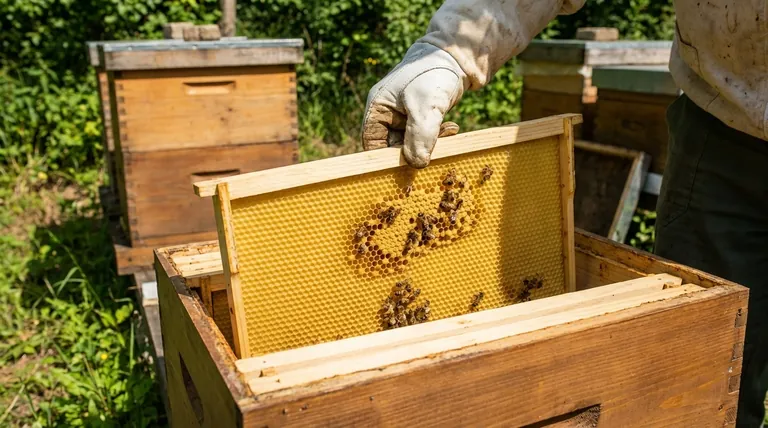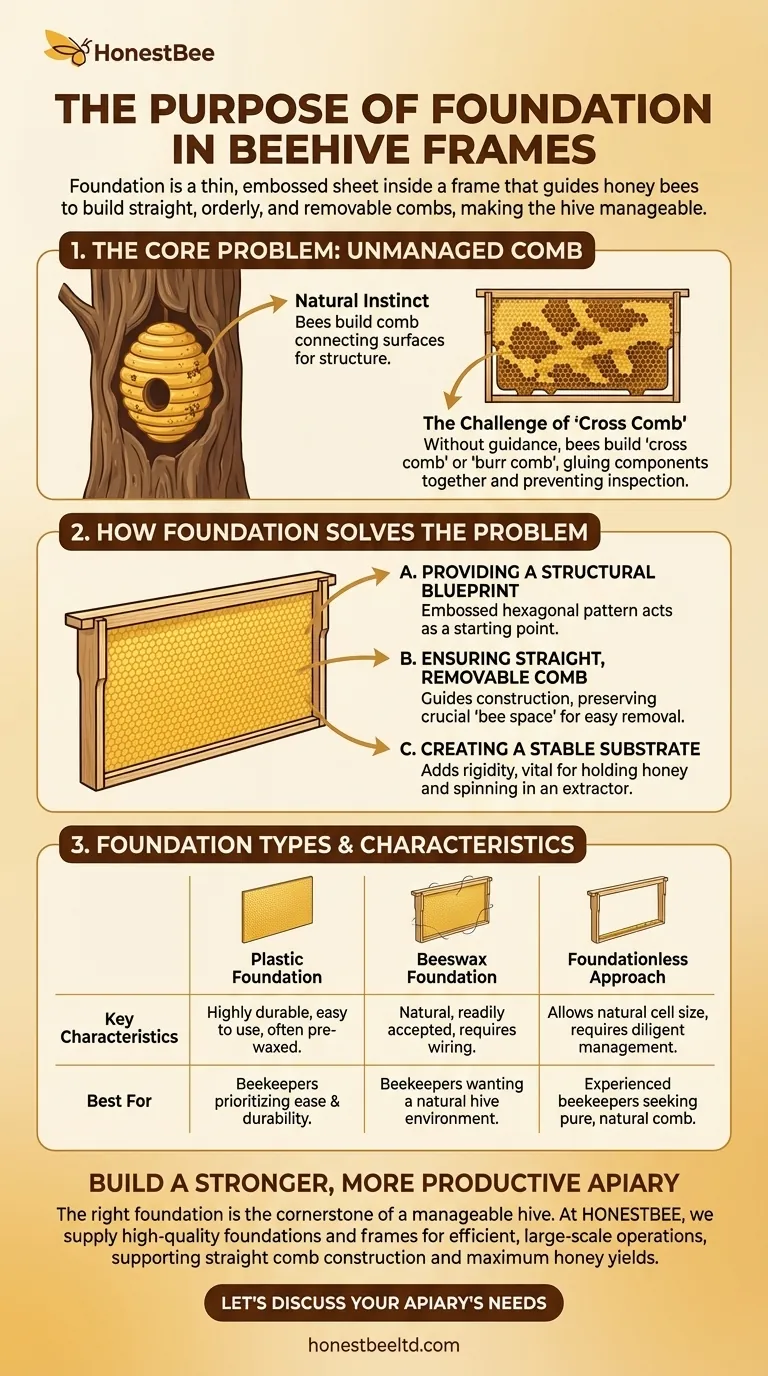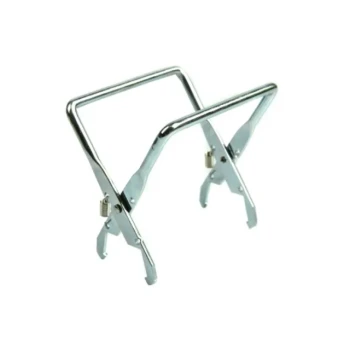In beekeeping, foundation is a thin sheet placed inside a frame that serves as a guide for honey bees. It is embossed with a hexagonal honeycomb pattern, encouraging bees to build straight, orderly, and removable combs within the confines of the frame. This structure is the fundamental difference between a wild hive and a managed one.
The core purpose of foundation is not just to give bees a place to start, but to impose a specific structure on their construction. This control is what makes a modern beehive manageable, inspectable, and productive for the beekeeper.

The Core Problem: Unmanaged Comb Construction
To understand the role of foundation, you must first understand what bees do without it. A honey bee's primary goal is to build comb for raising young and storing food as efficiently as possible.
The Bee's Natural Instinct
Left to their own devices in an open cavity, bees will build comb in patterns that suit them, not a beekeeper. They will often build comb that connects multiple surfaces, curving and weaving it to maximize structural integrity and space.
The Challenge of "Cross Comb"
In a modern beehive, this natural tendency results in cross comb (or burr comb)—wax that connects adjacent frames or attaches frames to the hive walls. This effectively glues the hive components together, making it impossible to remove a single frame for inspection without destroying the comb and harming bees.
How Foundation Solves the Problem
Foundation introduces a blueprint that directs the bees' building instincts into a predictable and orderly system. This makes the entire hive manageable.
Providing a Structural Blueprint
The embossed hexagonal pattern on a sheet of foundation acts as an irresistible starting point. The bees immediately recognize the pattern and begin "drawing out" the wax from this base, building their cells directly upon the provided guide.
Ensuring Straight, Removable Comb
By providing this guide in the center of each frame, the beekeeper ensures the bees build a single, straight sheet of comb. This preserves the crucial "bee space" between frames, allowing each frame to be lifted out cleanly for inspection, disease management, and honey harvesting.
Creating a Stable Substrate
Foundation provides a rigid backbone for the delicate wax comb. This structural integrity is vital, especially when frames heavy with honey are spun in an extractor to harvest the honey. Without a stable foundation, the comb would likely disintegrate under the centrifugal force.
Understanding the Trade-offs: Foundation Types
The choice of foundation material involves balancing convenience, durability, and bee acceptance. Each type has distinct characteristics.
Plastic Foundation
This is the most durable and easy-to-use option, often sold pre-coated with a thin layer of beeswax. Its rigidity eliminates the need for extra wiring, and it can be cleaned and reused for many seasons. However, bees can sometimes be slower to build on plastic if it isn't adequately waxed.
Beeswax Foundation
As the most natural option, beeswax foundation is readily accepted by bees. It is more fragile than plastic and typically requires reinforcement with wires threaded through the frame to prevent sagging, especially in hot weather or during honey extraction.
The Foundationless Approach
Some beekeepers choose to use no foundation at all, simply providing an empty frame with a small starter strip of wood or wax along the top bar. This allows bees to build their own natural-sized cells but requires more diligent management to prevent cross comb. This method is generally recommended for more experienced beekeepers.
Making the Right Choice for Your Hive
Selecting the right foundation is a foundational decision for your beekeeping journey. Your goals for the hive will determine the best path forward.
- If your primary focus is ease of use and durability: Pre-waxed plastic foundation is the most reliable and forgiving choice for new beekeepers.
- If your primary focus is a more natural hive environment: Wired beeswax foundation provides a natural substrate that bees readily accept.
- If you are an experienced beekeeper seeking pure, natural comb: A foundationless approach offers the most natural result but demands careful oversight.
Ultimately, foundation is the tool that enables a cooperative partnership between the beekeeper and the bees.
Summary Table:
| Foundation Type | Key Characteristics | Best For |
|---|---|---|
| Plastic | Highly durable, easy to use, often pre-waxed | Beekeepers prioritizing ease and durability |
| Beeswax | Natural, readily accepted by bees, requires wiring | Beekeepers wanting a natural hive environment |
| Foundationless | Allows natural cell size, requires diligent management | Experienced beekeepers seeking pure, natural comb |
Ready to build a stronger, more productive apiary?
The right foundation is the cornerstone of a manageable hive. At HONESTBEE, we supply commercial apiaries and beekeeping equipment distributors with the high-quality, durable foundations and frames needed for efficient, large-scale operations. Our wholesale-focused approach ensures you get the reliable equipment that supports straight comb construction, easy inspections, and maximum honey yields.
Let's discuss your apiary's needs. Contact our expert team today to explore our full range of beekeeping supplies and equipment.
Visual Guide

Related Products
- Beeswax Foundation Sheets Beehive Foundation for Wholesale
- Notebook Style Beeswax Foundation Mould Wax Foundation Mold
- Food Grade Plastic bee Foundation for Bee Frames
- Colorful Silicone Beeswax Foundation Mold Mould for Beekeeping
- Manual Beeswax Comb Foundation Machine Wax Foundation Mill Embossing Machine
People Also Ask
- What are the sizes of natural worker and drone cells? Guide to Natural Beehive Architecture
- What happens if foundation is given to colonies during a nectar dearth? Avoid Wasted Equipment and Stressed Bees
- What are the potential issues if the wax or dipping process is not properly managed? Avoid Cracks, Ripples, and Delamination
- How do beeswax foundations save bees time and energy? Boost Hive Productivity & Honey Yield
- What are the characteristics of beeswax foundation? A Natural Choice for Healthy Hives



















